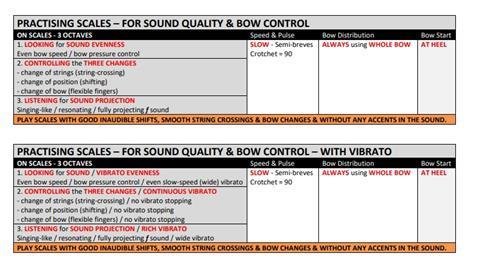Violin professor at Royal Birmingham Conservatoire and Junior Guildhall Ivo Stankov offers advice for creating your best sound

Discover more Technique articles like this in The Strad Playing Hub
Producing a beautiful tone is one of three essential elements of instrumental playing, alongside intonation and rhythm. It is easier said than done however, as the process of good ‘quality tone’ production requires a constant awareness of how we use the bow. Developing such an attention to detail can greatly impact on the consistency and quality of our sound production. To facilitate that process I would suggest to focusing on the following four sound qualities:
1. Even Tone
Sustaining the tone evenly throughout the bow can easily be overlooked, particularly in playing longer note values. Such concept of ‘sound evenness’ requires that both the level of sound and its quality need to be equally sustained as the whole bow is used. The bow’s natural weight ‘unevenness’ at both ends must be compensated by applying pressure evenly when playing towards the tip, and releasing that pressure gradually when approaching the heel. Therefore, thinking of these two bow actions technically – bow tilt and pressure, can help us to achieving evenness of sound in the process: tilting while releasing pressure towards the bow heel, and straightening the bow hair while applying pressure towards the tip. The bow speed must be equally monitored by attentive listening to the tone quality produced.
Here is a chart with action reminders for practising an even sound:

2. Resonating Tone
It is particularly helpful to think about how each violin string naturally resonates to produce a sustained quality sound. Lower strings such as G and D are thicker for example, and require using generally more bow pressure and bow speed than A and E. Focusing on the production of a rich, full-bodied harmonically speaking sound can really help us to identify that beautiful, ‘ringing-like’ tone quality of each note played on each string – a tone which has been produced accordingly to that string’s own resonance colour. To achieve that, experimentation and listening will eventually lead us to establishing the appropriate bow contact point, while using the exact balance required between the amount of bow pressure and bow speed.
Here is a video and a PDF chart to help practicing an even, resonating tone on scales:

3. Singing Tone
Many pedagogues and performers would agree, that singing your repertoire can help a great deal in learning about phrasing and expression as we are discovering and connecting with the music ideas in a piece. The same could be applied to the tone quality while playing – thinking about how a singer would vocalise each sound, will connect the technique of our external hand movements of the bow to our internal ability of singing and breathing. The perception of our ‘down and up’ bow’s movements will eventually transform into ‘sung’ phrases instead, aiming to be produced with the most beautiful singing-like tone quality.
That process is however, conditioned on a life-long journey of educating our musical ears and developing a personal taste for a singing-like tone through listening to as much music as possible, performed in a variety of stiles by different performers. These rich and varied sound experiences and ideas can have a great positive impact on our perception of a ‘singing-like’ tone. Using vibrato appropriately is of course, part of the equation, although we shouldn’t allow it to cover or compensate for sound imperfections. I would recommend practicing scales of long bows first without vibrato, and then with vibrato as well as dynamics:
No vibrato:
Vibrato:
Vibrato and Dynamics
Read: Aaron Rosand on how to produce a beautiful tone
Read: 7 ways to improve your tone
Listen: The Strad Podcast Episode #56: Richard Markson on teaching tone and sound
4. Projecting Tone
As violinists or violists, we have an acoustic problem to solve in the fact that our instrument is held close to our ear. It is quite easy therefore, to fall into the trap of playing at a sound volume which we are happy to listen to, and not considering enough the fact that the sound vibrations need to be carried a further distance in reaching the audience. Here is an important principle: the volume of sound we hear to be appropriate in our ear when performing (especially in a concert hall) has to be adjusted according to the performance space. We could think of such an adjustment as tone projection or the ability to playing at the sound level that will reach comfortably to the audience (and to the very back seats of the concert hall!) rather than using as a measure our own ear for it.
Our perception of dynamic level has to be adjusted to a louder-than-indicated dynamics level in the music score. When following such advice, we must take extra care not to fall into the assumption that everything in the music score must be played loud all the time, and we mustn’t allow for our projecting sound to change the style or the character of the piece either.
When considering our tone production, we should think about the appropriate style and character of each piece first. That will determine to great extend the type of sound (and appropriate use of vibrato) that we should play with.
Listening, experimenting, and thinking specifically about the bow making an even, resonating, singing and projecting tone will hopefully create an awareness and a habit to constantly enhance our tone production.
Further information about sound production and tone quality can be found here: https://www.violin-tips.com/sound-dynamics
Find more resources here: www.violin-tips.com











































No comments yet